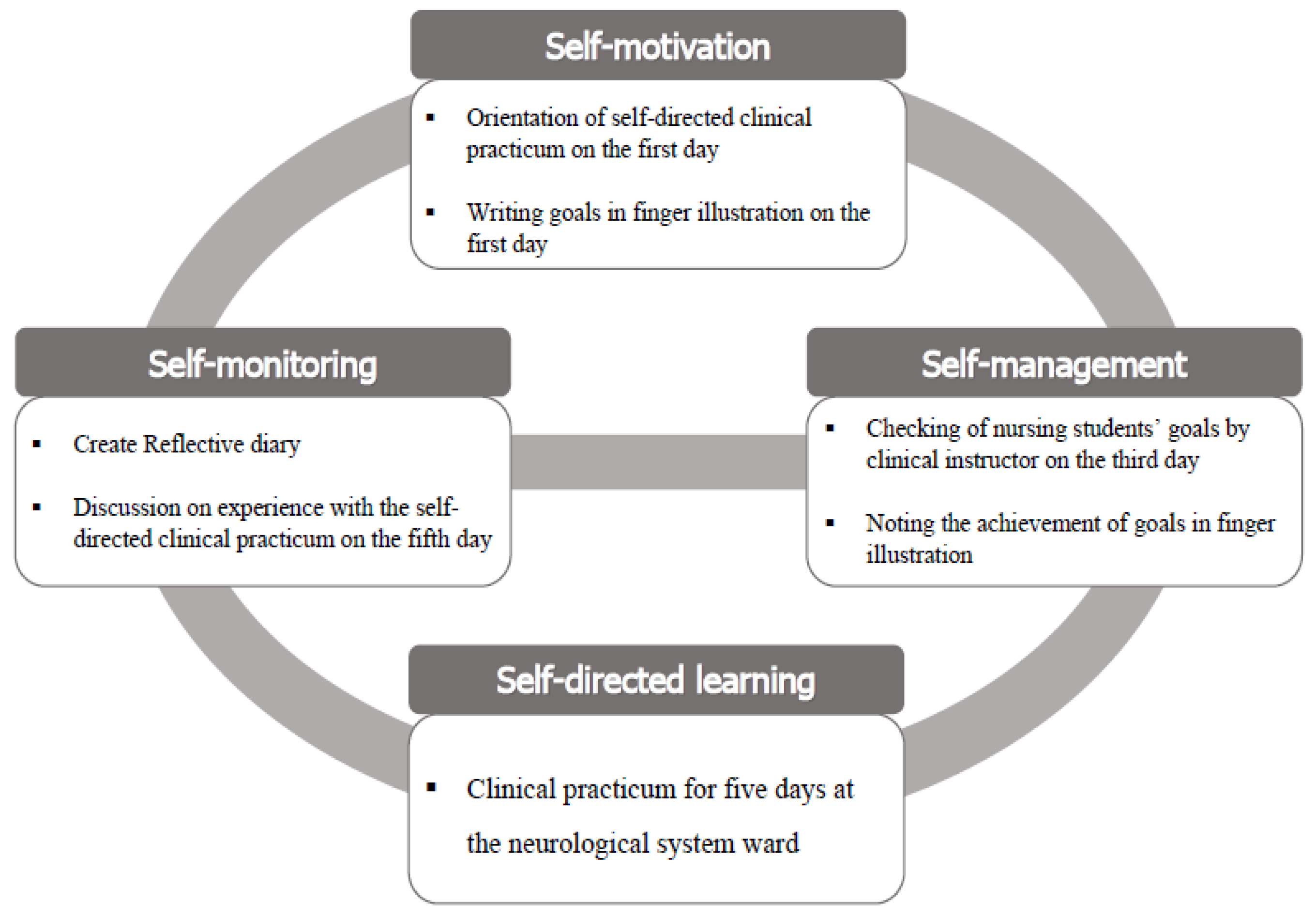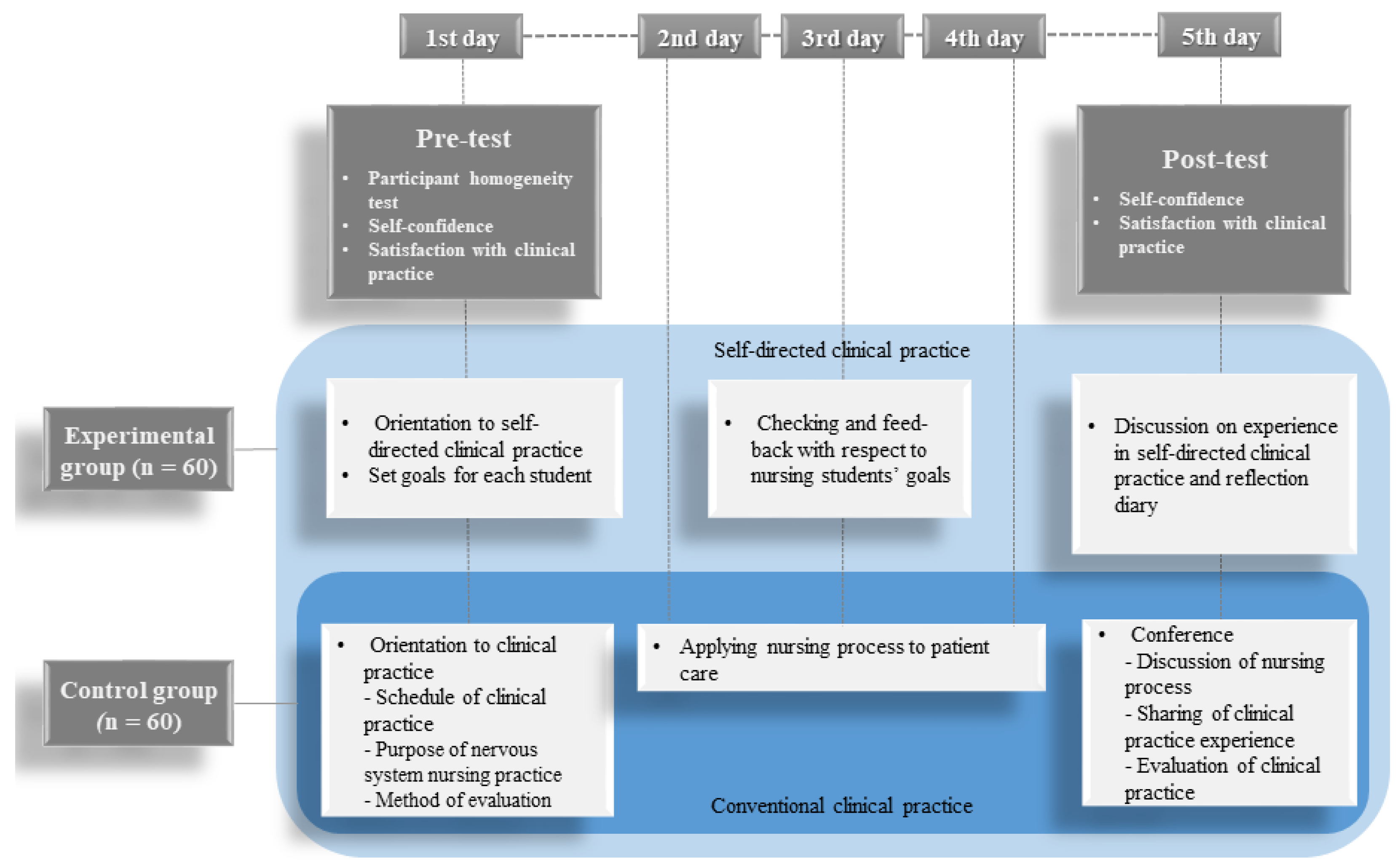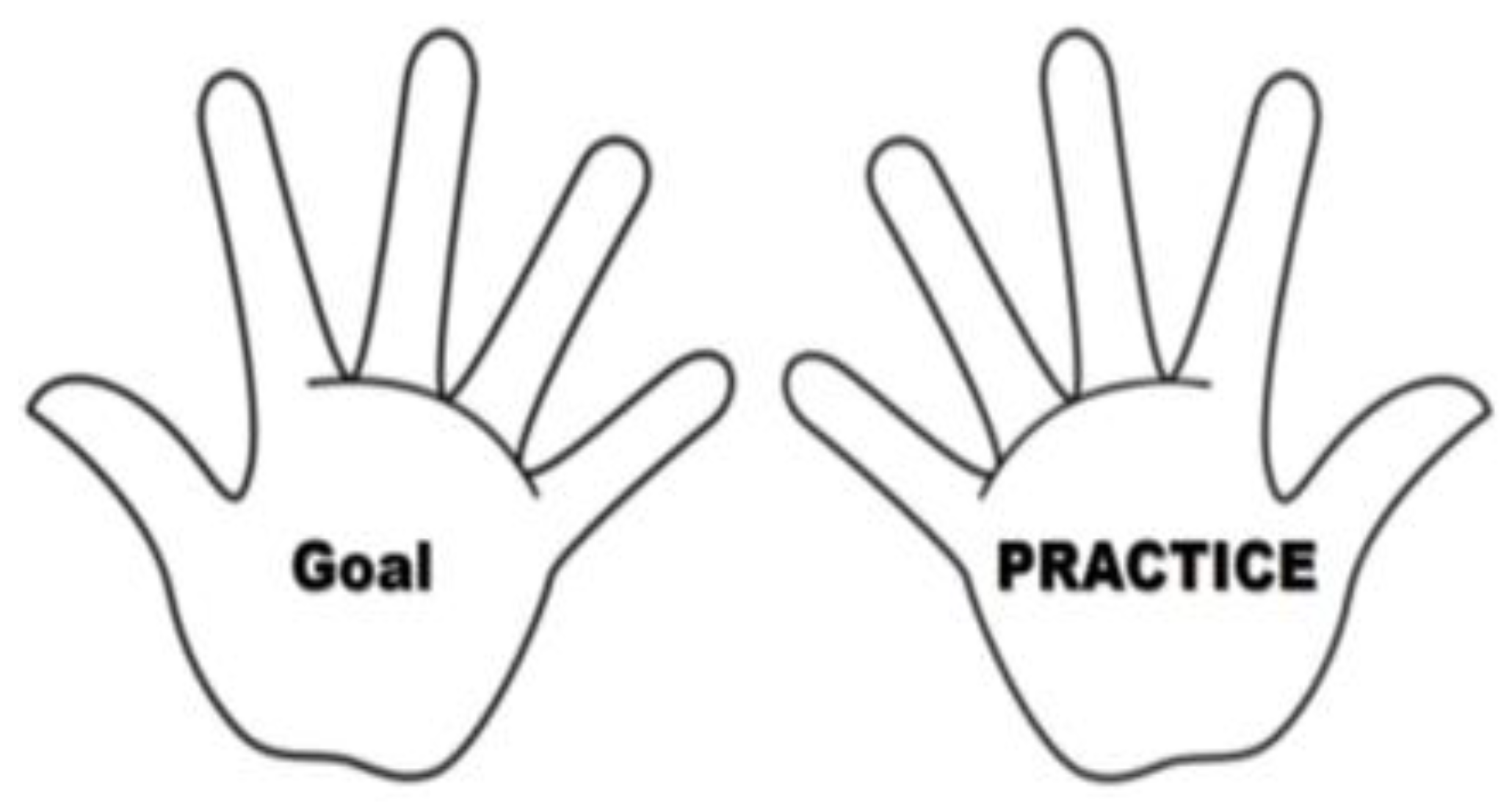Effects of a Self-Directed Clinical Practicum on Self-Confidence and Satisfaction with Clinical Practicum among South Korean Nursing Students: A Mixed-Methods Study
Abstract
1. Introduction
2. Background
3. Purpose
4. Materials and Methods
4.1. Design
4.2. Setting
4.3. Sample
4.4. Measurement
4.4.1. Self-Confidence
4.4.2. Satisfaction with the Clinical Practicum
4.4.3. Content Validity
4.5. Self-Directed Clinical Practicum
4.6. Data Collection
4.7. Ethical Considerations
4.8. Data Analysis
5. Results
5.1. Homogeneity Test
5.2. Effects of Self-Directed Clinical Practicum
5.3. Experience of Self-Directed Clinical Practicum
5.3.1. Perceived Linking of Academic Knowledge and Practice
“So far, I have had clinical practicum experiences that separated academic knowledge from the clinical practicum. In this neurology clinical practicum, as I tried to define my nursing plans and goals, I applied my knowledge naturally to my practicum as much as possible. Consequently, I got satisfactory results, and I was very satisfied with this practicum”.
“There was a clear difference between what I learned in theoretical classes in school and what I did in clinical practice. I think learning something by doing it in person during clinical practice made it clearer and easier to understand”.
5.3.2. Perceived Development of Nursing Competency
“It was an opportunity to become more active in the clinical practicum, and I saw development in my nursing knowledge and skills as I revised and changed my unsatisfactory areas. I also experienced self-reflection”.
“The more I practiced, the more questions I had; this urged me to practice more. Through this, I found my own development, unlike in my previous clinical practice”.
5.3.3. Enjoying the Clinical Practicum
“I was really worried about the practicum in adult nursing, as I expected it to be the most difficult part, but contrary to my expectation, I found it to be so enjoyable. I enjoyed this practicum”.
“I became more interested in nursing while doing SDCP. Unlike before, I tried to learn and tried hard. I thought the RNs liked my behavior and answered my questions more kindly”.
“This practicum was so nice and beneficial for me, because I set up the nursing goals or skills that I wanted to attain, and I tried to practice one every day. Therefore, I never felt it was very difficult, and it made me excited to practice more”.
5.3.4. Establishing Nursing Identity as a Student
“I was able to observe and practice more comprehensive nursing care rather than checking electronic nursing records for my homework, and I felt that a nurse’s job was very appealing”.
“It was a clinical practicum that allowed me to think deeply about nursing”.
6. Discussion
7. Conclusions
Author Contributions
Funding
Institutional Review Board Statement
Informed Consent Statement
Data Availability Statement
Conflicts of Interest
Appendix A. The List of Questions
Appendix A.1. Self-Confidence
- I am confident in collecting patient’s health history data.
- I am confident in performing a physical assessment.
- I am confident in analyzing meaningful data.
- I am confident in making a nursing plan according to the nursing diagnosis.
- I am confident in making nursing diagnoses according to nursing problems.
- I am confident in changing the nursing plan according to the change of the patient’s condition.
- I am confident in planning care that meets the needs of patients and their families.
- I am confident in making a nursing plan that can be combined with the doctor’s treatment plan.
- I am confident to include the use of community resources in nursing plans for patients and their families.
- I am confident in understanding the basic principles of a doctor’s prescription.
Appendix A.2. Satisfaction with the Clinical Practicum
- Clinical practicum provided new experiences according to the learning progress.
- Rather than simply learning, it was practiced to experience actual nursing work.
- What I learned at school was also applied to clinical practice.
- During clinical practice, I took care of patients according to the nursing process.
- The practice was focused on applying the knowledge learned during the lecture.
- I performed problem-focused nursing on patients rather than simple functional tasks.
- I sometimes had nothing to do during clinical practice.
References
- Falk, K.; Falk, H.; Ung, E.J. When practice precedes theory—A mixed methods evaluation of students’ learning experiences in an undergraduate study program in nursing. Nurse Educ. Pract. 2016, 16, 14–19. [Google Scholar] [CrossRef] [PubMed]
- Jayasekara, R.; Smith, C.; Hall, C.; Rankin, E.; Smith, M.; Visvanathan, V.; Friebe, T.R. The effectiveness of clinical education models for undergraduate nursing programs: A systematic review. Nurse Educ. Pract. 2017, 29, 116–126. [Google Scholar] [CrossRef] [PubMed]
- Sajadi, M.; Fayazi, N.; Fournier, A.; Abedi, A.R. The impact of the learning contract on self-directed learning and satisfaction in nursing students in a clinical setting. Med. J. Islam. Repub. Iran 2017, 31, 72. [Google Scholar] [CrossRef] [PubMed][Green Version]
- Strandell-Laine, C.; Saarikoski, M.; Loyttyneimi, E.; Salminen, L.; Suomi, R.; Leino-Kilpi, H. Effectiveness of a mobile cooperation intervention during the clinical practicum of nursing students: A parallel group randomized controlled trial protocol. J. Adv. Nurs. 2017, 73, 1502–1514. [Google Scholar] [CrossRef] [PubMed]
- Lee, S.G.; Shin, Y.H. Effects of self-directed feedback practice using smartphone videos on basic nursing skills, confidence in performance and learning satisfaction. J. Korean Acad. Nurs. 2016, 46, 283–292. [Google Scholar] [CrossRef] [PubMed]
- Perry, P. Concept analysis: Confidence/self-confidence. Nurs. Forum. 2011, 46, 218–230. [Google Scholar] [CrossRef] [PubMed]
- Alanazi, A.A.; Nicholson, N.; Thomas, S. The use of simulation training to improve knowledge, skills, and confidence among healthcare students: A systematic review. J. Allied Health Sci. Pract. 2017, 15, 2. [Google Scholar] [CrossRef]
- Rubber, J.; Rossman, C. Satisfaction and self-confidence with nursing clinical simulation: Novice learners, medium-fidelity, and community settings. Nurse Educ. Today 2017, 48, 140–144. [Google Scholar]
- Kang, K.A.; Kim, S.; Kim, S.J.; Oh, J.; Lee, M. Comparison of knowledge, confidence in skill performance (CSP) and satisfaction in problem-based learning (PBL) and simulation with PBL educational modalities in caring for children with bronchiolitis. Nurse Educ. Today 2015, 35, 315–321. [Google Scholar] [CrossRef] [PubMed]
- Gibbs, J.; Trotta, D.; Overbeck, A. Human patient simulation versus case study: Which teaching strategy is more effective in teaching nursing care for the hypoglycemic patient? Teach. Learn. Nurs. 2014, 9, 59–63. [Google Scholar] [CrossRef]
- James, B.; Beattie, M.; Shepherd, A.; Armstrong, L.; Wilkinson, J. Time, fear and transformation: Student nurses’ experiences of doing a practicum (quality improvement project) in practice. Nurse Educ. Pract. 2016, 19, 70–78. [Google Scholar] [CrossRef] [PubMed]
- Kirkpatrick, M.K.; Esterhuizen, P.; Jesse, E.; Brown, S.T. Improving self-directed learning/intercultural competencies: Breaking the silence. Nurs. Educ. 2015, 40, 46–50. [Google Scholar] [CrossRef] [PubMed]
- Tao, Y.; Li, L.; Xu, Q.; Jang, A. Development of a nursing education program for improving Chinese undergraduates’ self-directed learning: A mixed-method study. Nurse Educ. Today 2015, 35, 1119–1124. [Google Scholar] [CrossRef] [PubMed]
- Devi, S.; Bhat, K.; Ramya, S.; Ravichandran, K.; Kanungo, R. Self-directed learning to enhance active learning among the 2nd-year undergraduate medical students in Microbiology: An experimental study. J. Curr. Res. Sci. Med. 2016, 2, 80–83. [Google Scholar] [CrossRef]
- Shahrouri, E. The impact of garrison’s model of self-directed learning improving academic self-concept for undergraduate students. Int. J. Educ. Learn. Dev. 2016, 4, 36–45. [Google Scholar]
- Kim, K. A study on the influence between self-directed learning and nursing students’ satisfaction of clinical practice. J. Korean Clin. Health Sci. 2016, 4, 571–581. [Google Scholar] [CrossRef]
- Garrison, D. Self-directed learning: Toward a comprehensive model. Adult. Educ. Q. 1997, 48, 18–33. [Google Scholar] [CrossRef]
- Faul, F.; Erdfelder, E.; Lang, A.; Buchner, A. G*Power 3: A flexible statistical power analysis program for the social, behavioral, and biomedical sciences. Behav. Res. Methods 2007, 39, 175–191. [Google Scholar] [CrossRef] [PubMed]
- Kellar, S.P.; Kelvin, E. Munro’s Statistical Methods for Health Care Research, 6th ed.; Lippincott Williams and Wilkins: Philadelphia, PA, USA, 2012; pp. 61–75. [Google Scholar]
- Krippendorff, K. Content Analysis: An Introduction to its Methodology, 2nd ed.; Sage: Beverly Hills, CA, USA, 2004; pp. 81–87. [Google Scholar]
- Cohen, J. Statistical Power Analysis for the Behavioral Sciences, 2nd ed.; Lawrence Erlbaum Associates: Hillsdale, NJ, USA, 1988; pp. 1–17. [Google Scholar]
- Zhang, X.; Meng, L.; Liu, H.; Luo, R.; Zhang, C.; Zhang, P.; Liu, Y. Role of academic self-efficacy in the relationship between self-directed learning readiness and problem-solving ability among nursing students. Front. Nurs. 2018, 5, 75–81. [Google Scholar] [CrossRef]
- Alotaibi, K.N. The learning environment as a mediating variable between self-directed learning readiness and academic performance of a sample of Saudi nursing and medical emergency students. Nurse Educ. Today 2016, 36, 249–254. [Google Scholar] [CrossRef] [PubMed]



| Characteristics | Classification | Exp. (n = 55) | Con. (n = 56) | χ2/t | p |
|---|---|---|---|---|---|
| n (%)/M ± SD | n (%)/M ± SD | ||||
| General characteristics | |||||
| Gender | Male | 6 (10.9) | 7 (12.5) | 0.07 | 0.794 |
| Female | 49 (89.1) | 49 (87.5) | |||
| Age | 21.86 ± 1.20 | 21.98 ± 1.15 | 0.56 | 0.577 | |
| Perceived academic grade | High | 2 (3.6) | 6 (10.7) | 4.45 * | 0.126 |
| Moderate | 49 (89.1) | 41 (73.2) | |||
| Low | 4 (7.3) | 9 (16.1) | |||
| General satisfaction of clinical practicum | 3.25 ± 0.63 | 3.25 ± 0.65 | 0.19 | 0.854 | |
| Completed clinical practicum subjects | Adult nursing | 55 (100.0) | 56 (100.0) | - | - |
| Psychiatric nursing | 54 (98.2) | 54 (96.4) | 0.33 * | >0.999 | |
| Pediatric nursing | 54 (98.2) | 56 (100.0) | 1.41 * | 0.495 | |
| Woman’s nursing | 54 (98.2) | 55 (98.2) | 0.00 * | >0.999 | |
| Community nursing | 20 (36.4) | 56 (100.0) | 66.27 * | <0.001 | |
| Nursing management | 35 (63.6) | 42 (75.0) | 1.69 | 0.194 | |
| Baseline score | |||||
| Self-confidence | 3.26 ± 0.43 | 3.33 ± 0.59 | 0.80 | 0.427 | |
| Satisfaction with the clinical practicum | 3.21 ± 0.40 | 3.32 ± 0.47 | 1.24 | 0.217 | |
| Variable | Experimental Group (n = 55) | Control Group (n = 56) | t | E.S. | p | ||||
|---|---|---|---|---|---|---|---|---|---|
| Mean ± SD | Mean ± SD | ||||||||
| Baseline Score | Final Score | Change Score | Baseline Score | Final Score | Change Score | ||||
| Self-confidence | |||||||||
| 3.26 ± 0.43 | 3.71 ± 0.56 | 0.46 ± 0.44 | 3.33 ± 0.59 | 3.46 ± 0.54 | 0.13 ± 0.44 | 3.98 | 0.76 | <0.001 | |
| Satisfaction with the clinical practicum | |||||||||
| 3.21 ± 0.40 | 3.85 ± 0.38 | 0.64 ± 0.40 | 3.32 ± 0.47 | 3.48 ± 0.46 | 0.17 ± 0.35 | 6.53 | 1.25 | <0.001 | |
Publisher’s Note: MDPI stays neutral with regard to jurisdictional claims in published maps and institutional affiliations. |
© 2022 by the authors. Licensee MDPI, Basel, Switzerland. This article is an open access article distributed under the terms and conditions of the Creative Commons Attribution (CC BY) license (https://creativecommons.org/licenses/by/4.0/).
Share and Cite
Park, H.; Cho, H. Effects of a Self-Directed Clinical Practicum on Self-Confidence and Satisfaction with Clinical Practicum among South Korean Nursing Students: A Mixed-Methods Study. Int. J. Environ. Res. Public Health 2022, 19, 5231. https://doi.org/10.3390/ijerph19095231
Park H, Cho H. Effects of a Self-Directed Clinical Practicum on Self-Confidence and Satisfaction with Clinical Practicum among South Korean Nursing Students: A Mixed-Methods Study. International Journal of Environmental Research and Public Health. 2022; 19(9):5231. https://doi.org/10.3390/ijerph19095231
Chicago/Turabian StylePark, Hyangjin, and Haeryun Cho. 2022. "Effects of a Self-Directed Clinical Practicum on Self-Confidence and Satisfaction with Clinical Practicum among South Korean Nursing Students: A Mixed-Methods Study" International Journal of Environmental Research and Public Health 19, no. 9: 5231. https://doi.org/10.3390/ijerph19095231
APA StylePark, H., & Cho, H. (2022). Effects of a Self-Directed Clinical Practicum on Self-Confidence and Satisfaction with Clinical Practicum among South Korean Nursing Students: A Mixed-Methods Study. International Journal of Environmental Research and Public Health, 19(9), 5231. https://doi.org/10.3390/ijerph19095231






